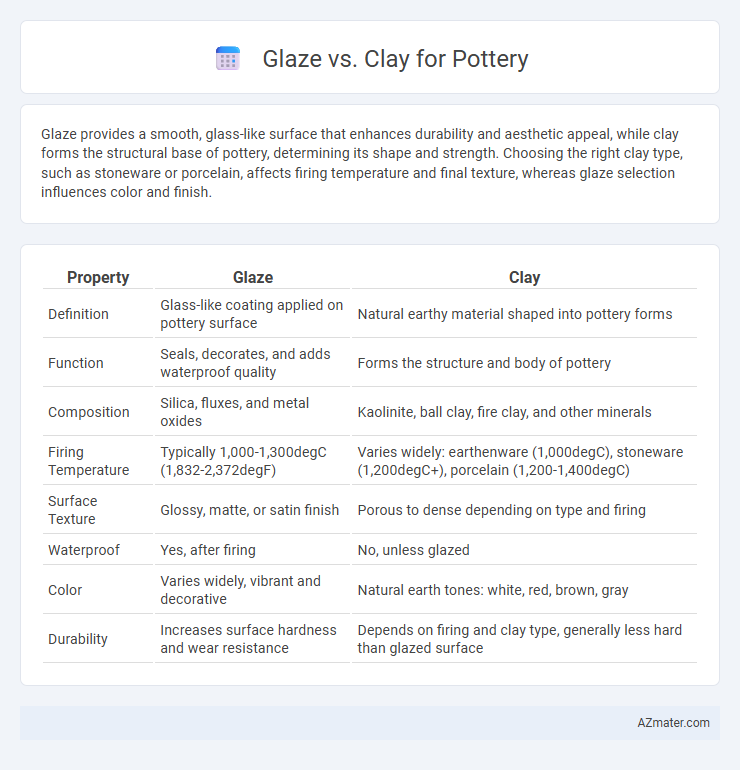Glaze provides a smooth, glass-like surface that enhances durability and aesthetic appeal, while clay forms the structural base of pottery, determining its shape and strength. Choosing the right clay type, such as stoneware or porcelain, affects firing temperature and final texture, whereas glaze selection influences color and finish.
Table of Comparison
| Property | Glaze | Clay |
|---|---|---|
| Definition | Glass-like coating applied on pottery surface | Natural earthy material shaped into pottery forms |
| Function | Seals, decorates, and adds waterproof quality | Forms the structure and body of pottery |
| Composition | Silica, fluxes, and metal oxides | Kaolinite, ball clay, fire clay, and other minerals |
| Firing Temperature | Typically 1,000-1,300degC (1,832-2,372degF) | Varies widely: earthenware (1,000degC), stoneware (1,200degC+), porcelain (1,200-1,400degC) |
| Surface Texture | Glossy, matte, or satin finish | Porous to dense depending on type and firing |
| Waterproof | Yes, after firing | No, unless glazed |
| Color | Varies widely, vibrant and decorative | Natural earth tones: white, red, brown, gray |
| Durability | Increases surface hardness and wear resistance | Depends on firing and clay type, generally less hard than glazed surface |
Understanding the Basics: What is Clay in Pottery?
Clay in pottery is a natural, malleable material composed of fine-grained minerals that becomes plastic when wet and hardens upon firing. It serves as the foundational medium for shaping and creating pottery pieces before any surface treatments like glaze are applied. Understanding the properties of various clay types, such as earthenware, stoneware, and porcelain, is essential for selecting the right clay body based on firing temperature and desired durability.
What is Glaze and Why is it Used in Pottery?
Glaze is a glass-like coating applied to pottery to create a waterproof, decorative, and durable surface. It fuses to the clay body during firing, enhancing both the aesthetic appeal and functionality of ceramic pieces by preventing moisture absorption and increasing resistance to wear. Used extensively in pottery, glaze transforms porous clay into a smooth, non-porous, and visually vibrant material.
Types of Clay Used in Pottery Making
Stoneware clay, known for its durability and fire resistance, is favored in pottery for both functional and decorative pieces, often paired with glossy or matte glazes to enhance surface texture. Earthenware clay, softer and more porous, requires low-temperature glazes that seal the surface, allowing vibrant colors and intricate designs to flourish. Porcelain clay, prized for its fine texture and translucency, demands high-temperature glazes that vitrify the body, producing smooth, delicate pottery often used for fine china and art pieces.
Common Types of Pottery Glazes
Common types of pottery glazes include gloss, matte, satin, and satin-matte finishes, each providing different textures and visual effects. Glossy glazes create a shiny, reflective surface, while matte glazes offer a non-reflective, smooth finish; satin glazes fall between these two, delivering a soft sheen. Clay bodies interact uniquely with these glazes depending on their composition, affecting durability, color retention, and firing temperature compatibility.
The Role of Clay in Shaping Pottery Pieces
Clay provides the essential structural foundation for pottery, influencing the shape, texture, and durability of the final piece. Its mineral composition and plasticity determine the potter's ability to mold intricate forms and withstand firing temperatures. Clay's interaction with glaze significantly affects surface finish and overall aesthetic quality in ceramic art.
Glaze Application Techniques and Their Effects
Glaze application techniques such as dipping, brushing, and spraying significantly impact the texture, color intensity, and finish of pottery compared to clay surfaces. Dipping ensures an even coating with smooth, glossy results, while brushing allows for detailed designs and varied thickness, creating textured or matte effects. Spraying offers a uniform, fine mist application that enhances subtle color gradients and reduces glaze pooling, unlike the natural porous and matte finish of unglazed clay.
Comparing Physical Properties: Clay vs Glazed Surfaces
Clay surfaces exhibit porous and matte textures that allow moisture absorption and retain tactile warmth, while glazed pottery features smooth, non-porous coatings that enhance durability and resist water penetration. The glaze creates a glass-like finish improving chemical resistance and ease of cleaning, contrasting with raw clay's vulnerability to stains and scratches. Differences in thermal expansion between clay bodies and glaze can influence the structural integrity and visual appeal of ceramic pieces.
Functional Differences: Durability, Porosity, and Safety
Glaze forms a vitrified, glass-like coating on pottery, significantly enhancing durability by making the surface non-porous and resistant to liquids and stains, while clay remains porous and can absorb moisture unless fired to a very high temperature. Unglazed clay pottery is more prone to chipping and cracking due to its porous nature and weaker surface compared to glazed pieces. From a safety perspective, glazed pottery, when properly formulated and fired, provides a non-toxic, sealed surface suitable for food and drink, whereas unglazed clay may harbor bacteria and contaminants due to its absorbent properties.
Aesthetic Impact: Color, Texture, and Finish
Glaze offers vibrant color options, glossy or matte finishes, and a smooth, glass-like texture that enhances the visual appeal of pottery. Clay provides a natural, earthy aesthetic with varied textures and softer, matte finishes that highlight the raw material's organic qualities. Choosing between glaze and clay significantly influences the overall look, texture, and tactile experience of the final ceramic piece.
Choosing Between Glaze and Raw Clay for Pottery Projects
Choosing between glaze and raw clay in pottery projects hinges on the desired finish and functionality; glaze adds a glossy, waterproof surface that enhances durability and aesthetic appeal, while raw clay offers a natural, matte texture ideal for rustic or sculptural works. Glazed pottery is more resistant to stains and easier to clean, making it suitable for functional ware like bowls and mugs. Raw clay pieces, though porous and less durable without firing, emphasize tactile qualities and organic beauty preferred in decorative or experimental creations.

Infographic: Glaze vs Clay for Pottery
 azmater.com
azmater.com